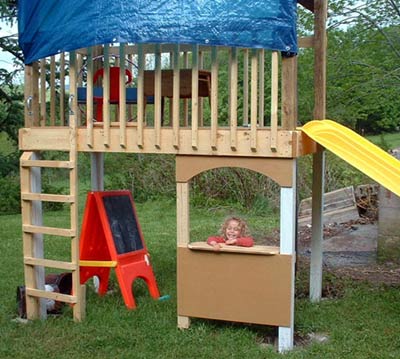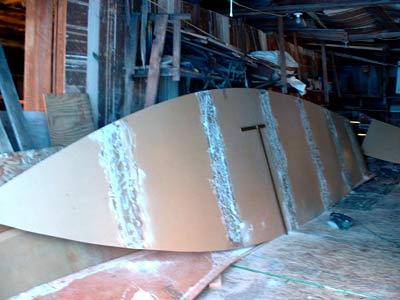|
Cormorant
Cormorant
has only been crawling along, mostly because of the slide/fort/playset
I've mentioned on the Yahoo group. It was a great joy for me to
build it for the girls, and a great joy for them to watch it appear
out of a pile of lumber -- but it took up many hours that might've
been spent on Cormorant. Such is life. Both projects serve the
same goal -- a happy family. (Only the boat also serves my private
sail-mania, but that doesn't count as much.) And you should see
all the joints -- screwed and glued and lagged and bolted like
a Buehler schooner! This thing will last 50 years. I've attached
a picture of the fort -- prior to its gabled roof and swingset,
with just a tarp flung over it for shade. Note that all the ply
used in construction is Cormorant offcuts . . .

Below is a photo of Cormorant's bottom panel (first of two layers).
I preassembled it with glass butt joints so as to be guaranteed
of a perfect centerline, rather than risk jogging my panels if
I'd applied them piecemeal. My barn floor is very uneven and unlevel
and keeping everything straight and untwisted will be the main
challenge now. I didn't preglass it completely, as I did with
the side and bilge panels, as I'll probably throw a layer of glass
between the two laminations of 1/2" MDO for the bottom (this
is for ply-glass-ply composite puncture resistance -- one of my
little pet worries/theories), and then of course, glass and/or
Dynel on the outside. I'll leave the nice paper surface of the
MDO facing into the interior, so painting will go easily inside
the boat. The bottom is about 25' long, and the rest of the boat
length is in the upswept bow section. That's a 4' sheetrock T-square
for scale in the picture.

I'm pretty much resigned to this taking all the rest of this year
and no launch till spring 2005. Best not to rush and botch it,
I figure.

Sanding
I rented a floor sander yesterday and sanded my
(preglassed) hull panels for Cormorant. It worked like a dream
-- each pass took off just enough to completely scuff the surface,
and level out any bumps -- without cutting down to the glass.
It was 100-grit paper on an 8" drum sander. 120- or 150-grit
would have been even better, but not available. If I ever lingered
too long in one spot, it would gouge a bit into the glass. I learned
to keep moving quickly and smoothly. Took about 2 easy hours to
do both sides of 4 panels. And I did our splintery outdoor porch,
too, to justify the $35 expense of renting the sander.


pieces laid out - going 3-D

all bulkheads in, awaiting bottom and bilge
panels
After all the lead-up to this, starting last September
when I was doing the flat-glassing, through making my bulkheads
indoors by the woodstove this winter -- it happened surprisingly
quickly. Five or six hours out in the barn today and it went from
being a bunch of 2-D pieces to looking like a big boat. And though
some pieces were pretty big, I got it all set up working solo,
with the help of a few clamps and some strong language. Just epoxied
and screwed the joints for now, and once I'm sure it's all straight
and untwisted, I'll do fillets with glass on all the joints throughout.

|

